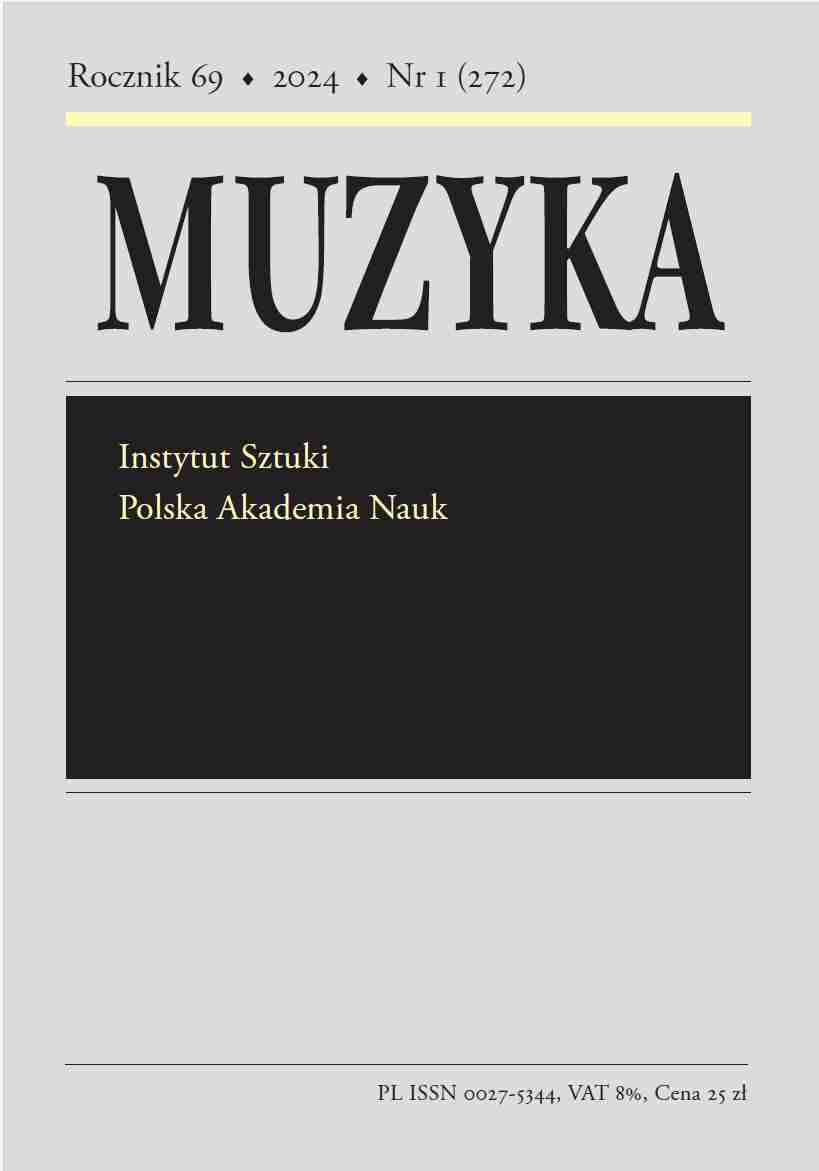„Miserere” na głosy i instrumenty Pawła Szymańskiego. Konstrukcja dźwiękowa i znaczenia
Violetta Kostka
Akademia Muzyczna im. Stanisława Moniuszki w Gdańsku (Polska)
https://orcid.org/0000-0002-1655-8485
Abstrakt
Niniejszy artykuł jest poświęcony Miserere na głosy i instrumenty (1993) Pawła Szymańskiego, a jego celem jest omówienie konstrukcji dźwiękowej utworu oraz przypisanych mu znaczeń. Bazując na analizie utworu i różnorodnej literaturze autorka stwierdza, że Miserere jest utworem jawnie intertekstualnym, do tego skomponowanym swobodnie, tj. bez użycia metod algorytmizowanych. Cechą charakterystyczną tego utworu jest to, że zawiera nie jedną, a dwie struktury wyjściowe: modalny chorał gregoriański i czterogłosowy kanon w poszerzonej tonalności dur-moll. Obie struktury wyjściowe zostały połączone z sobą w całość za pomocą − typowych dla Szymańskiego − abstrakcyjnych pomysłów. Dosyć łatwo rozpoznać, że solowe psalmodie występują w kształcie sprzed wieków, natomiast partie chóralne barwowo przypominają chorał, ale zamiast śpiewu monodycznego zawierają recytacje na sześciu wysokościach dźwięku i fragmenty szeptane. Z porównania kanonu z ostateczną kompozycją wynika, że ten pierwszy stał się podstawą odcinków zespołowych Miserere, w tym głównie partii wiolonczel i wibrafonu i że pominięto wiele jego dźwięków (około 1/3). Na koniec rozważań na temat konstrukcji utworu padają informacje o trzyczęściowej formie. Kwestię znaczeń autorka otwiera przyjętym przez siebie stanowiskiem kognitywistycznym, z którego wynika, że znaczenia nie tkwią w utworze, lecz że utwór prowokuje interpretatora do ich stworzenia. Powołując się na własne skojarzenia, opinie krytyków muzycznych i literaturę psychologiczną o emocjach, autorka ustala, że każdej z trzech części Miserere można przypisać uczucia: równowagi, niepokoju i powrotu do równowagi. Oprócz tekstu artykuł zawiera otrzymany od kompozytora początek wyjściowego kanonu, fragment Miserere w opracowaniu autorki oraz tabelę ukazującą formę kompozycji.
Słowa kluczowe:
Paweł Szymański, Miserere, intertekstualność , struktura ukryta , transformacje , znaczeniaBibliografia
Biblia Tysiąclecia Online, https://biblia.deon.pl/rozdzial.php?id=884, dostęp 5 III 2021.
Google Scholar
Fauconnier, Gilles, Mark Turner. The Way We Think: Conceptual Blending and the Mind’s Hidden Complexities. New York: Basic Books, 2002.
Google Scholar
Fauconnier, Gilles, Mark Turner. Jak myślimy: Mieszaniny pojęciowe i ukryta złożoność umysłu. Przekł. Izabela Michalska. Warszawa: Biblioteka Kwartalnika KRONOS, 2019.
Google Scholar
Juslin, Patrik N., Petri Laukka. „Communication of Emotions in Vocal Expression and Music Performance: Different Channels, Same Code?”. Psychological Bulletin 129, nr 5 (2003): 770–814.
DOI: https://doi.org/10.1037/0033-2909.129.5.770
Google Scholar
Kostka, Violetta. Muzyka Pawła Szymańskiego w świetle poetyki intertekstualnej postmodernizmu. Gdańsk–Kraków: Akademia Muzyczna im. Stanisława Moniuszki, Musica Iagellonica, 2018.
Google Scholar
Miserere mei, Deus: Psalm 50 (51) w interpretacji św. Tomasza z Akwinu: tekst w języku łacińskim i tłumaczenie na język polski z komentarzami, red. Mirosław Mróz. Toruń: Wydawnictwo Naukowe UMK, 2010.
Google Scholar
Naliwajek, Katarzyna. „Modele struktury muzycznej w Bagatelle für A.W. Pawła Szymańskiego”. Muzyka 46, nr 1 (2001): 61–84.
Google Scholar
Naliwajek-Mazurek, Katarzyna. [tekst w książeczce do CD]. W: Camerata Silesia Sings Szymański [CD], 5–13. Warszawa: Dux Recording Producers, 2016.
Google Scholar
Nycz, Ryszard. „Poetyka intertekstualna: tradycje i perspektywy”. W: Kulturowa teoria literatury. Główne pojęcia i problemy, red. Michał P. Markowski, Ryszard Nycz, 153–180. Kraków: Universitas, 2012.
Google Scholar
Przybysz, Piotr. „Emocje muzyczne i ich estetyczne modyfikacje”. W: Neuroestetyka muzyki, red. Marcin Bogucki i in., 95–140. Poznań: PTPN, 2014.
Google Scholar
Ravasi, Gianfranco. Miserere: il piu celebre salmo penitenziale. Bologna: EDB, 2016.
Google Scholar
Rohrer, Tim. „Mimesis, Artistic Inspiration and the Blends We Live By”, Journal of Pragmatics 37, nr 10 (2005): 1686–1716.
DOI: https://doi.org/10.1016/j.pragma.2005.01.015
Google Scholar
Szwarcman, Dorota. „40 x Szymański”. Ruch Muzyczny 51, nr 1 (2007): 12–16.
Google Scholar
Szymański, Paweł. „From Idea to Sound. A Few Remarks on My Way of Composing”. W: From Idea to Sound. Proceedings of the International Musicological Symposium held at Castle Nieborów in Poland, 4–5 IX 1985, red. Anna Czekanowska, Miloš Velimirović, Zbigniew Skowron, 134–139. Kraków: Nakładem Fundacji Zjednoczonej Europy, 1993.
Google Scholar
Tikkanen, Amy. „Anxiety, Psychology”. W: Encyclopaedia Britannica, https://www.britannica.com/science/anxiety, dostęp 10 III 2021.
Google Scholar
Turner, Mark. The Origin of Ideas: Blending, Creativity, and the Human Spark. Oxford: Oxford University Press, 2014 [e-book].
Google Scholar
Wallace, B. Alan, Shauna L. Shapiro. „Mental Balance and Well-Being: Building Bridges Between Buddhism and Western Psychology”. American Psychologist 61, nr 7 (2006): 690–701.
DOI: https://doi.org/10.1037/0003-066X.61.7.690
Google Scholar
Zbikowski, Lawrence. Conceptualizing Music: Cognitive Structure, Theory, and Analysis. Oxford: Oxford University Press, 2002.
DOI: https://doi.org/10.1093/acprof:oso/9780195140231.003.0009
Google Scholar
Zbikowski, Lawrence. Foundations of Musical Grammar. Oxford: Oxford University Press, 2017.
DOI: https://doi.org/10.1093/oso/9780190653637.001.0001
Google Scholar
Autorzy
Violetta KostkaAkademia Muzyczna im. Stanisława Moniuszki w Gdańsku Polska
https://orcid.org/0000-0002-1655-8485
Statystyki
Abstract views: 506PDF downloads: 318
Licencja
Prawa autorskie (c) 2022 Violetta Kostka

Utwór dostępny jest na licencji Creative Commons Uznanie autorstwa – Użycie niekomercyjne – Bez utworów zależnych 4.0 Międzynarodowe.
Autor udziela wydawcy niewyłącznej i nieodpłatnej licencji (CC BY 4.0) na wykorzystanie tekstu w „Muzyce”, zachowuje nieograniczone prawa autorskie i zobowiązuje się do podawania miejsca pierwodruku w „Muzyce” przy ponownym wykorzystaniu artykułu (umowa licencyjna do pobrania). Zgłaszając artykuł do publikacji, autor wyraża zgodę na jego udostępnianie na licencji CC BY 4.0.
Artykuły w zeszytach od 2018/1 do 2022/3 publikowane były na licencji CC BY-NC-ND 4.0. W tym okresie autorzy/ki udzielali wydawcy niewyłącznej i nieodpłatnej licencji (CC BY-ND 4.0) na wykorzystanie tekstu w „Muzyce”, zachowywali nieograniczone prawa autorskie, ale zobowiązywali się do podawania miejsca pierwodruku przy ponownym wykorzystaniu artykułu.
Inne teksty tego samego autora
- Violetta Kostka, „Musicae Scientiae” 22 (2018) nr 1 [wydanie specjalne pt.] „Creative Conceptual Blending in Music”, red. Emilios Cambouropoulos, Danae Stefanou, Costas Tsougras , Muzyka: Tom 66 Nr 4 (2021)










